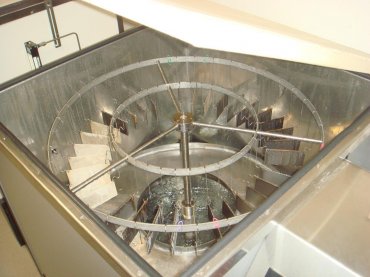
Corrosion inhibitor demand in the United States is projected to rise 3.1 percent per year and reach $2.8 billion by 2020, a new study by Freedonia Group finds. Key industries and markets such as fuel and lubricant additives will drive demand for these chemical compounds.
Demand for corrosion inhibitors used in additives for fuel and lubricants, which are included in the studys petroleum refining category, will have modest growth of 1 percent, rising from $280 million in 2015 to $315 million in 2020, Freedonia analyst Jason Carnovale told Lube Report.

Photo: King Industries
ASTM D1748 test exposes metal panels to 100 percent relative humidity at 49 C, and evaluates the rust after 24 hours. Corrosion inhibitors used in metals manufacturing will rise 3 percent to $295 million by 2020, says Freedonia.
In general, the lubricant and fuel additives market is relatively mature, with fairly modest lubricant production growth due to issues well known to the lubricants industry, – such as long OEM-specified drain intervals – preventing more rapid advances in corrosion inhibitor demand, said Carnovale. However, the need for high value corrosion inhibitors or slightly increased inhibitor loadings to allow those long drain intervals will provide opportunities.
In the chemicals manufacturing industry, overall economic growth, as well as low energy and feedstock prices, will bring up demand for corrosion inhibitors. Demand for these chemical compounds reached $420 million in 2015 for this sector, and are forecast to rise 3.8 percent to $505 million in 2020. Basic chemicals, petrochemicals and polymers will benefit most from corrosion inhibitor usage, he said.
Metals manufacturing is another key market that will see growing need for corrosion inhibitors. For the metals industry, activity in energy intensive segments such as steel mills is expected to increase, despite the issue of overcapacity in China, said Carnovale. This will require additional corrosion inhibitors in cooling water, as well as pickling and other applications. Freedonia projects an increase of 3 percent for this segment, from $255 million in 2015 to $295 million in 2020.
The shipping industry will also benefit from increased economic activity, and this will drive demand for rust preventatives, volatile corrosion inhibitors, and other products used to protect finished metal surfaces in storage and transportation, he added.
Industry trends will continue shaping corrosion inhibitor formulations to have better performance, noted Carnovale. For corrosion inhibitors used as product additives, the focus is on product performance as a method to provide value-added benefits, he said. A simple example is the continued spread of organic acid corrosion inhibitors in antifreeze in place of lower value products.This technology is well entrenched at this point, but continues to increase in share.
Corrosion inhibitors are also being formulated to respond to increasing environmental regulations related to water usage at manufacturing facilities. Both phosphorus and nitrogen are present in corrosion inhibitors and can contribute to microbiological growth and harm ecosystems, and both state and federal regulations are increasingly requiring water to be treated to reduce levels of these chemicals, explained Carnovale. Alternatively, water uses can switch from these lower cost inhibitors to those based on carboxylic acids and other environmentally acceptable organic chemistries.
|
U.S. Corrosion Inhibitor Demand (millions of dollars) |
|||||
|
Year |
% Annual Growth |
||||
|
2010 |
2015 |
2020 |
2010-2015 |
2015-2020 |
|
| Total Demand |
2,060 |
2,450 |
2,810 |
3.5 |
2.8 |
| Petroleum Refining |
465 |
545 |
600 |
3.2 |
1.9 |
| Utilities |
445 |
480 |
550 |
1.5 |
2.8 |
| Chemicals Manufacturing |
375 |
420 |
505 |
2.3 |
3.8 |
| Oil and Gas Production |
270 |
390 |
460 |
7.6 |
3.4 |
| Metals |
195 |
255 |
295 |
5.5 |
3 |
| Pulp and Paper |
145 |
150 |
160 |
0.7 |
1.3 |
| Other Markets |
165 |
210 |
240 |
4.9 |
2.7 |
Source: The Freedonia Group
The 203-page study, titled Corrosion Inhibitors, is $5,300 from Cleveland-based Freedonia Group. For more information, visit www.freedoniagroup.com.